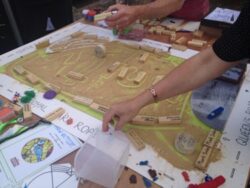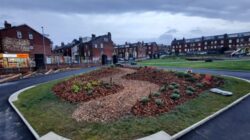The community-university-council partnership that created Royal Park
In honour of the official opening of the new Royal Park in Hyde Park Leeds this month, we are taking a deep dive into the community-university-city partnership that brought this greenspace to life.
Historical importance of the space
This new park is located on the site of the historical Royal Park Primary School.
The school functioned as a hub for the local community. There are many parents of children in the neighbourhood who had attended the school themselves, with fond memories of their time there. The building was also used to host a variety of community events and to celebrate weddings. It had been a landmark for the neighbourhood, both because of its central location and its social importance.
However, due to changes in the neighbourhood and local education systems, the school was closed in 2004 and demolished in 2014. This outcome felt devastating for the local community and affected many people deeply. Conversations between community members, the council, and property developers continued for years about what the site would become. Eventually, a decision was made to turn the site into a new park.
Co-producing the park’s design
Because of the historical importance of this space to the local community, engaging them in the design of the new park was crucial.
A community consultation was facilitated by Hyde Park Source, a local community organisation with over 20 years of expertise in engaging communities with the creation and maintenance of local green spaces for health and wellbeing.
This consultation included an online survey, an in person focus group, and three ‘planning for real’ sessions at local events. These sessions included an interactive activity to visualise the potential for the park and a display board where community members could provide their opinions. From this consultation, it was clear that the community still felt strongly that this site should be a centre of community activity. The community made suggestions that the site include an orchard and a wildflower garden to increase biodiversity and food for pollinators, community art, and a community garden where local people could get involved and children could learn about food growing and woodworking.
This information fed into Leeds City Council’s design for the park.

Image of a ‘planning for real’ session facilitated by Hyde Park Source for the design of Royal Park
Co-creating the park through a community-university-council partnership
In 2020, Leeds City Council invested £500,000 into the revitalisation of the space with the hope of addressing the needs of the Hyde Park community that had been voiced during the consultation.
Remnants of the school can be found throughout the park, as Hyde Park Source’s Design and Build team were commissioned to create benches out of the school’s stone boys and girls signs.
In 2022, researchers at the University of Leeds in partnership with Hyde Park Source secured funding to run a weekly community gardening group as part of an action research project on community cohesion and belonging in green space. 15 volunteers made up of local residents and students living in the Hyde Park area created the orchard and community gardens over the course of 6 months with the permission of Leeds City Council and the help of Hyde Park Source. These volunteers also repainted the rainbow fence railings that are an iconic part of the site as a tribute to the school.
Pieces of the school’s history can also be found near the new playground, where a circle of tiles painted by children who attended the school still remain. University of Leeds students further contributed to the park’s development in 2023 through a colourful mural across the wall of the outdoor playground that the council installed. This community art was part of the celebration for Leeds2023, organised by the University’s Sustainability Service to provide students more opportunities to give back to their local community.
A small but dedicated ‘Friends of Royal Park’ group has now been established, with the hope of returning a sense of community ownership to the site. It was with the help of Hyde Park Source and volunteers from the community that this group is possible.

Conclusions
The Hyde Park neighbourhood has an incredibly low ratio of greenspace to grey built environment, with many houses not having gardens of their own. Through critical collaborations between the local communities, community organisations, the council, and University of Leeds faculty and students, this site has begun the new chapter of its life – as the neighbourhood park.
Parks and greenspace play a crucial role in the city’s response to climate change. The investment in new greenspaces in areas of deprivation is a target outlined in the Leeds Parks and Greenspaces Strategy, as is working more closely with the communities and volunteer groups that live near these greenspaces. Through collaborating effort with environmental groups such as Hyde Park Source and ‘Friends of’ groups, communities can take an active role in the care and preservation of their greenspaces.
These types of collaborative partnerships can be immensely beneficial for communities and councils; however, they are not without their challenges and learning opportunities. That’s why researchers at the University of Leeds have partnered with Hyde Park Source and Leeds City Council in a new positive impact partnership funded by Policy Leeds to examine what is needed for public-civic partnerships to flourish.
United Nations Sustainable Development Goals
We use the United Nations Sustainable Development Goals (SDGs) as a framework to guide our activity. Our work on Positive Impact Partners is linked to the following SDGs:
- Goal 9: Industry, innovation and infrastructure
- Goal 11: Sustainable cities and communities
- Goal 17: Partnerships
Find out more about our impact on the SDGs.



